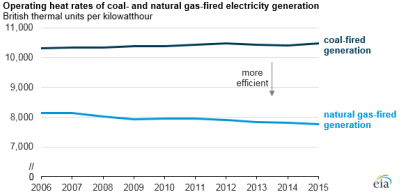EIA: Natgas-fired electricity conversion efficiency grows, coal remains stable
From 2006 to 2015, annual average heat rates of natural gas-fired electricity generators decreased 7% as heat rates of coal-fired electricity generators remained stable, increasing only 1%. Heat rates are calculated based on the amount of energy (measured in British thermal units) reported to EIA that was used to generate a unit of electricity. Lower heat rates indicate more efficient generation, because less fuel is needed per kilowatthour.
 |
| Courtesy of EIA. |
In 2006, the heat rate for all natural gas-fired generation averaged 8,471 British thermal units per kilowatthour (Btu/kWh), about 18% lower than the average heat rate of 10,351 Btu/kWh for coal-fired generation. With stable coal-fired heat rates and declining natural gas-fired heat rates since that time, the average heat rate for natural gas-fired generation was about 25% lower than the average heat rate for coal-fired generation in 2015, based on the latest available annual data.
The small rise in the average operating heat rate for coal-fired generation may be attributed to emissions controls. Emissions-control equipment was installed on almost 205 gigawatts (GW) of coal capacity from 2006 to 2015, or about 73% of the coal-fired generator fleet that was operating in 2016. These emissions-control measures often require more on-site usage of electricity, which involves consuming fuel but not necessarily producing electricity output.
Emissions-control investments were also made at about 37.5 GW of natural gas-fired generators, or about 9% of the natural gas fleet. However, relative to the effects on coal-fired generation, these investments have not been a significant influence on average operating efficiency trends for natural gas-fired generation.
Changes in usage patterns of coal and natural gas plants could affect their heat rates. Plants that are cycled on and off more frequently—as opposed to being operated more continuously—may consume more fuel to produce electricity, especially during ramping periods (times of increasing demand for electricity).
The rise in coal generators’ heat rates—likely attributable to increased on-site electricity use as a result of operational changes and emissions controls—was partially offset by the net effects of adding 19.5 GW of more-efficient new coal generating capacity while retiring 43.1 GW of relatively less-efficient coal capacity. Coal units installed between 2006 and 2015 had a weighted-average design heat rate of 9,665 Btu/kWh, compared with the coal units that retired over this period, which had a weighted average design heat rate of 10,343 Btu/kWh.
One main factor in the improvement of the natural gas fleet’s heat rate is changes in the types of natural gas-fired electricity generators. Unlike coal, natural gas has two distinct types of electricity-generating technologies: combined cycle and simple cycle. Combined-cycle systems are significantly more efficient. The capacity of natural gas-fired units added since 2006 has been, on average, more efficient than the existing fleet, and the natural gas-fired capacity retired since 2006 has been, on average, less efficient. Almost 58 GW of combined-cycle capacity, with a weighted-average design heat rate of 7,029 Btu/kWh, was added between 2006 and 2015. Nearly 34 GW of natural gas capacity, with a weighted average design heat rate of 11,218 Btu/kWh, retired during that period.
Over time, as more combined-cycle units have been installed, they have made up a larger portion of the natural gas generator fleet and accounted for a larger share of natural gas-fired generation. In 2015, natural gas-fired combined-cycle technology operated at an average heat rate of 7,340 Btu/kWh. In contrast, simple-cycle natural gas-fired generators, which encompass several distinct technology types (gas turbines, internal combustion engines, and steam turbines), operated at a consumption-weighted average heat rate of 9,788 Btu/kWh. Combined-cycle systems accounted for 75% of total natural gas-fired generation in 2006. By 2015, this share had increased to 85%. The increased use of the more efficient technology resulted in a lower overall average operating heat rate for natural gas-fired units.

- ExxonMobil halts 1-Bft3d blue hydrogen project in Texas
- Aramco and Yokogawa commission multiple autonomous control AI agents at Fadhili gas plant
- Ukraine will resume gas imports via Transbalkan route in November
- Mitsubishi to inject $260 MM into Brunei LNG project
- Freeport LNG (U.S.) on track to take in more natgas on Thursday after unit outage



Comments